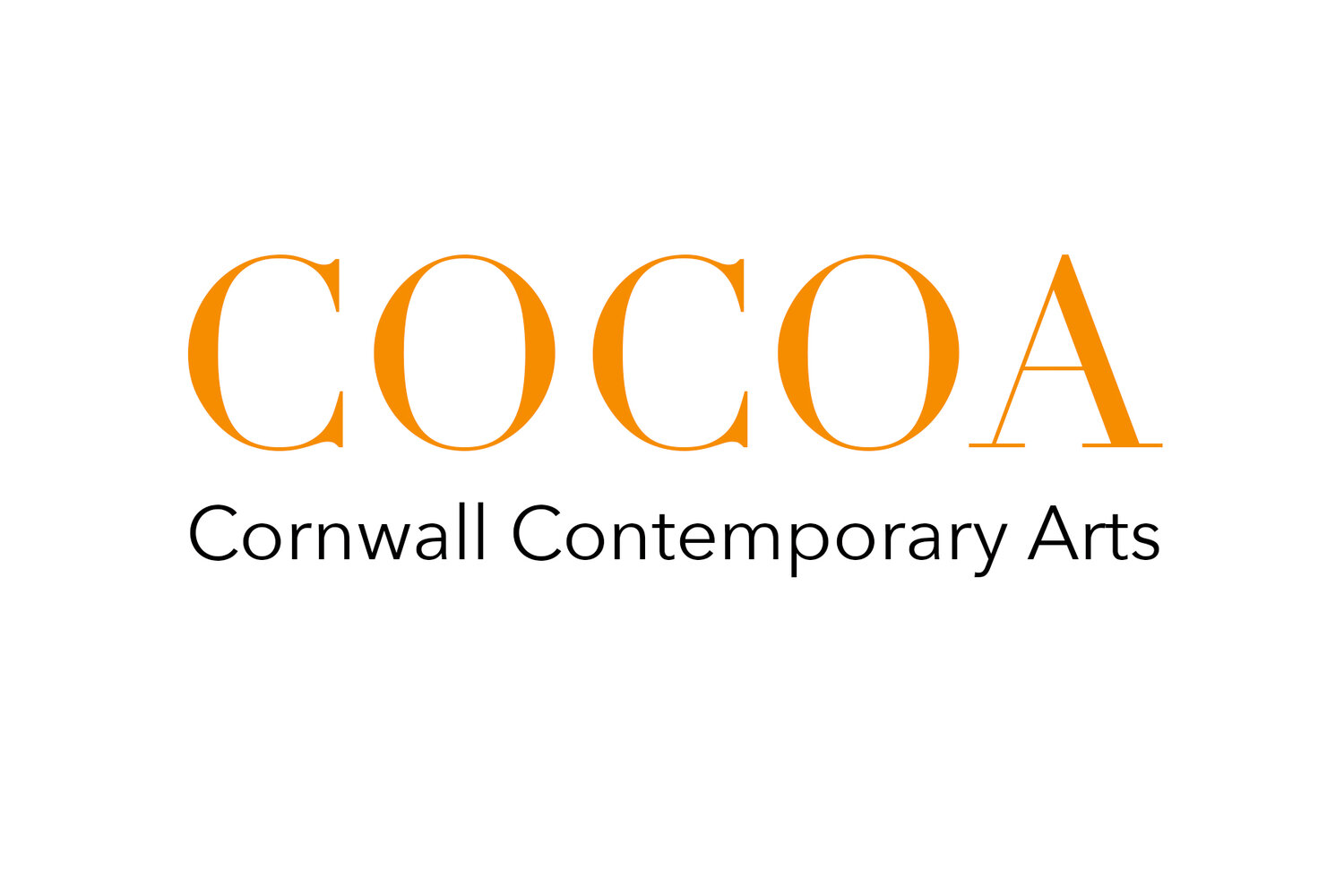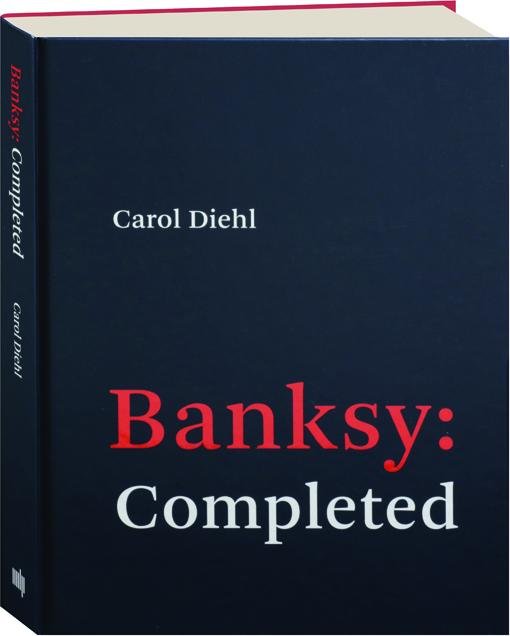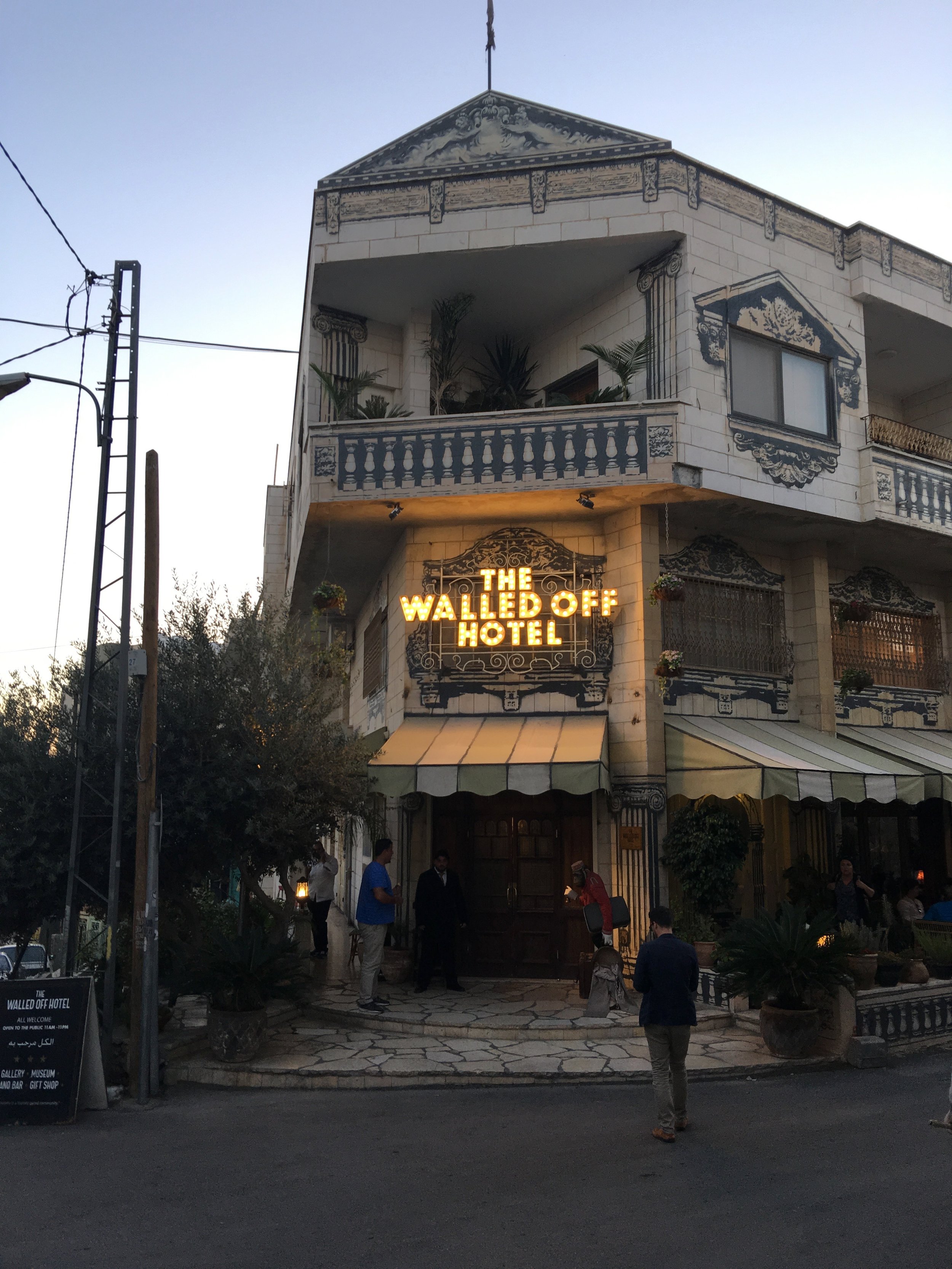Another Day, Another Banksy*
*Saltz, Jerry, Jerry Saltz on New York Graffiti Artists, Banksy, and Al Jazeera Fear, New York Magazine, Oct. 24, 2013 quoted in Banksy Completed, p. 20
Carol Diehl at Banksy’s The Walled Off Hotel, Palestinian West Bank. Photo: Terry Perk
Carol Diehl’s impassioned, lucid, and fascinating book Banksy: Completed was published in 2021. Anyone interested in contemporary art should read it. It made me radically reevaluate my take on the anonymous provocateur, whose 2013 one-month New York “residency” I had totally ignored. Like most people involved in the serious (ahem) art world, I had taken Banksy for a reasonably clever, certainly daring, but ultimately shallow performer of some kind of brand, kind of a parody of an artist. I couldn’t have been more wrong. Following is a back- and-forth with Diehl, an artist and writer who has been a longtime contributing editor at Art in America.
David Brody: Carol, in the book you reprimand contemporary art critics on both sides of the Atlantic for their snobbery and blindness to Banksy’s revolutionary impact. You seem to have been the one contemporary art critic with long-established credentials to take him seriously. What has happened since the publication of your book in terms of dialogue, if any, with other critics and the contemporary art world?
Banksy, Armored Dove of Peace, 2007, Bethlehem, Palestinian Territories. Photo: Carol Diehl
Carol Diehl: My point of view is different for several reasons. One is that I spend a lot of time in England where everyone is more familiar with Banksy. Also, I’ve had an appreciation for graffiti since it exploded on the NY subways in the 80s. My former art dealer, Sidney Janis, saw graffiti as an extension of his long-held interest in self-taught art, and his was the first blue-chip gallery to exhibit it. Plus, these are artists willing to risk their lives for their art. How many can say that?
So when Banksy came to New York for his 2013 “residency,” where he did an artwork in one of the five boroughs each day for a month, I saw critics eager to write about him for the clickbait, but eschewing the research they’d do if Banksy were represented by a mega-gallery. Certainly, if he were exhibiting at Gagosian, they’d have bothered to see his Academy Award-nominated film, “Exit Through the Gift Shop,” before putting pen to paper.
The result is that Banksy’s most elaborate works are still unknown. In 2015 he staged Dismaland, inviting 58 artists from around the world to address “the failure of capitalism” (not coincidentally the theme of the Venice Biennale that year) in a “theme park unsuitable for children” on the coast of Bristol, England. And in 2017, Banksy opened an artwork you can stay in, The Walled Off Hotel, adjacent to the dividing wall between Israel and Palestine in the West Bank city of Bethlehem. How many artists have created a hotel? If you depended on critics to tell you, you wouldn’t even know about this one.
Banksy, Dismaland, 2015, Weston-super-Mare, UK. Photo courtesy of Pest Control Office
So my book was really written for the skeptics. I was hoping that my reputation, as well as that of the publisher, The MIT Press, might persuade them to read it, but so far — except for you, David, and critic Deborah Solomon who was on board before I wrote it—their Banksy intransigence has not shifted. That said, I’m extremely pleased with the public reception and the opportunity to introduce my personal philosophy of art — greatly inspired by Robert Irwin, to whom the book is dedicated — to a general audience.
DB: In “Exit Through the Gift Shop” a French idiot-savant begins as a video chronicler of street artists including Banksy but ends up selling a million dollars’ worth of purpose-made street art by imitating him in the crassest possible way — in effect, embodying the image that people such as your friendly nemesis Jerry Saltz must imagine Banksy to be. (You recount in the book how you and Saltz went “head to head” about Banksy on Facebook.) One suspects a prank in a Banksy-directed film, but if the story is on the level perhaps that’s prank enough, considering that Banksy has been waging an all-out war against commodification and personal fame -- making auto-destructive works for auction, leaving his street art for others to sell, turning abandoned sites into massive installations on his own dime, and remaining anonymous (and un-arrested) against all odds.
What is particularly ironic is that while political art and institutional critique now reign supreme in the galleries and museums, Banksy’s interventions in Palestine and, recently, Ukraine, go unrecognized. But how could it be otherwise? Real institutional critique cannot be sanctioned by the institution. I mean, can we imagine a Banksy show at the Whitney?
CD: The art world is a bubble of privilege where institutional critique and political art amount to little more than elaborate virtue- signaling. Its effectiveness, or rather lack of it, was brought home to me when I went to the Met to see Philip Glass’s opera, Satyagraha, about that icon of civil disobedience, Mahatma Gandhi — after which guards were employed to steer the exiting audience clear of the actual Occupy protest taking place outside.
Banksy, no doubt, wouldn’t be any more interested in exhibiting at the Whitney than the museum would want to have him. For one thing, Banksy’s work is inspired by the situation, so to plop it on a random wall would cause it to lose its meaning — and the reaction, the story of what happens after, is an integral component, the reason I titled my book Banksy: Completed. Banksy’s a provocateur, and it’s unlikely the Whitney wants to be provoked.
DB: All graffiti contests the de facto ownership, which ordinarily goes unnoticed, of public space by advertisers and propagandists. Besides commonplace graffiti, there are more explicitly political precedents for Banksy’s work, such as Mark Pauline’s punk alterations of billboards around San Francisco in the ‘80s. In your book, you quote Banksy’s pithy articulation of this point of view: “Asking for permission is like asking to keep a rock someone just threw at your head.” How do you see him fitting into this underground tradition, given that he is now arguably the most famous artist in the world — indeed, in your words, “one of the geniuses of our time, a worthy bearer of the torch passed by Marcel Duchamp.”
Banksy, If Graffiti Changed Anything it Would be Illegal, 2011, spray painting, London. Photo courtesy of Pest Control Office
Banksy, You Complete Me, 2013, spray painting, New York. Photo: Joshua Tjaden
CD: Despite his fame, Banksy is clearly an “underground” phenomenon, considering that no one knows who he is. You can’t get more “underground” than that! And he still operates within the traditions of graffiti, in that the work appears unannounced, and when it’s over, it’s over — with any website he may have attached (as with Dismaland, for instance) also disappearing. In addition, there’s also no profit-making component; except for work done to support charities, Banksy has had nothing on the retail market since 2008.
Instead of fitting into any one category, Banksy has expanded our definition of what it means to be an artist, which is why I compare him to Duchamp — and why I wrote the book. His expression seems to have no boundaries when one considers that he’s produced an Academy Award-nominated film, a mini-Venice Biennale/amusement park on the British coast, built a hotel in one of the most conflicted areas of the world, financed and decorated a refugee rescue ship — as well as protesting art’s commodification with a surprise “performance” during a Sotheby’s auction.
In a world that lacks a significant anti-establishment art movement, Banksy, with his anti-capitalist, anti-war message, occupies a place all his own.
DB: Finally, Carol, what about your own artwork, which you describe on your website as marrying the literal with the abstract. Has it been affected by your immersion in Banksy’s world? My cursory observation would be that you seem to be moving from dense formal complexity toward a clarity of gesture and symbol, with recent work even adopting street techniques such as sprayed pigment and stencils.
Carol Diehl, Titania, 2013, graphite and ink on paper. Photo: Carol Diehl
More broadly, where is all this taking the practice of art? I once heard Thierry de Duve lecture on the idea of art as “communication.” Maybe, he mused, it’s just the opposite: in a world of constant informational bombardment, art could be the thing that interrupts the flow, that makes one stop in bewilderment. Surely much of the resistance within the art world to Banksy’s genius — I’ll take you up on that word, even though in many ways the greatest of his achievements, such as Dismaland and The Walled Off Hotel, are explicitly collaborative — is due to the long and ongoing fight for artistic freedom from literalism, or to put it in late 19th-century terms: art for art’s sake. Banksy’s popularity seems to threaten not only the institutions and the power structure, but also the lonely, obsessive philosopher-artist in his/her garret (mea culpa). Is there still a place for art that dives deeply into the self, into the process of its making, that seeks a kind of transcendent mystery ultimately beyond words and readable messages?
Banksy, The Walled Off Hotel, Palestinian West Bank. Photo: Carol Diehl
CD: Actually, as you can see from my website, which seems to have become stuck in 2011, I was using stencils and spray paint before I became aware of Banksy — although definitely, if unconsciously, [I was] influenced by street art. It’s as if I wanted to take the elements of public art to make something intensely personal. I love contradiction. The same with my use of letters, numbers, words, and random symbols in my art, my objective is to use them to create experiences beyond words — contradiction again.
I think we’ve romanticized the idea of the solitary artist laboring in their garret — which makes it all about ego, really — and I will posit that successful collaboration can also be an aspect of creative genius. Collaboration is just another tool, like paint.
It’s interesting to consider that two of my favorite artists, Olafur Eliasson and Ragnar Kjartansson, also work collaboratively. (And it’s likely no coincidence that they’re both Icelandic, as Iceland itself appears to be one big collaboration.) Yet their work is exceedingly individual. Consider that of Ragnar (whose 2012 video piece, The Visitors, was deemed in 2020 by The Guardian to be best work of the century so far), which is particularly personal, evoking an emotion I’ve been trying to describe ever since I first saw it — a feeling that’s neither sad nor happy, or maybe both sad and happy. The word “nostalgia” comes closest, except it’s not a nostalgia for anything I’ve known, but more like nostalgia for something I’ve yet to know. It’s a highly idiosyncratic emotion specific to Ragnar in whose work it appears again and again — yet the effect is produced by the individual contributions of a group of performers.
It’s the same with Banksy’s Dismaland. His seaside theme park was the combined work of 58 international artists who were offered the freedom to create what they wanted, all of which resulted in an effect, an atmosphere, that was more Banksy than Banksy. The artists were both internationally known and relatively unknown, but even work as familiar as Jenny Holzer’s Truisms became a Banksy in that context. Then there was Damien Hirst, an artist one might think of as representing the worst of capitalism, whose piece (one of my favorites) ironically seemed to illustrate the precariousness of individual freedom in a world ruled by money — a tabletop pierced by various upended knife blades over which, suspended by air, a beach ball danced frivolously.
I like to think that we’re entering a new era, as I quote Brian Eno in my book, where
[W]e don’t have to argue whether photographs are art, or whether performances are art… because we say, ‘Art is something that happens, a process, not a quality, and all sorts of things can make it happen.’… what makes a work of art ‘good’ for you is not something that is already ‘inside’ it, but something that happens inside you — so the value of the work lies in the degree to which it can help you have the kind of experience that you call art.
Carol Diehl at Dismaland with graffiti artist Pedro, 2015. Photo: Ray Harmon










